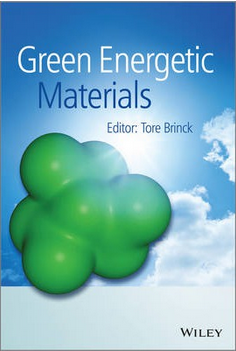
Green Energetic Materials
[BOOK DESCRIPTION]
This comprehensive book presents a detailed account of research and recent developments in the field of green energetic materials, including pyrotechnics, explosives and propellants. This area is attracting increasing interest in the community as it undergoes a transition from using traditional processes, to more environmentally-friendly procedures. The book covers the entire line of research from the initial theoretical modelling and design of new materials, to the development of sustainable manufacturing processes. It also addresses materials that have already reached the production line, as well as considering future developments in this evolving field.
[TABLE OF CONTENTS]
List of Contributors ix
Preface xi
1 Introduction to Green Energetic Materials 1 (14)
Tore Brinck
1.1 Introduction 1 (1)
1.2 Green Chemistry and Energetic Materials 2 (3)
1.3 Green Propellants in Civil Space Travel 5 (5)
1.3.1 Green Oxidizers to Replace Ammonium 6 (2)
Perchlorate
1.3.2 Green Liquid Propellants to Replace 8 (2)
Hydrazine
1.3.3 Electric Propulsion 10 (1)
1.4 Conclusions 10 (1)
References 11 (4)
2 Theoretical Design of Green Energetic 15 (30)
Materials: Predicting Stability, Detection,
Synthesis and Performance
Tore Brinck
Martin Rahm
2.1 Introduction 15 (2)
2.2 Computational Methods 17 (3)
2.3 Green Propellant Components 20 (18)
2.3.1 Trinitramide 20 (4)
2.3.2 Energetic Anions Rich in Oxygen and 24 (3)
Nitrogen
2.3.3 The Pentazolate Anion and its 27 (6)
Oxy-Derivatives
2.3.4 Tetrahedral N4 33 (5)
2.4 Conclusions 38 (1)
References 39 (6)
3 Some Perspectives on Sensitivity to 45 (18)
Initiation of Detonation
Peter Politzer
Jane S. Murray
3.1 Energetic Materials and Green Chemistry 45 (1)
3.2 Sensitivity: Some Background 46 (1)
3.3 Sensitivity Relationships 47 (1)
3.4 Sensitivity: Some Relevant Factors 48 (8)
3.4.1 Amino Substituents 48 (1)
3.4.2 Layered (Graphite-Like) Crystal 49 (1)
Lattice
3.4.3 Free Space in the Crystal Lattice 50 (1)
3.4.4 Weak Trigger Bonds 50 (1)
3.4.5 Molecular Electrostatic Potentials 51 (5)
3.5 Summary 56 (1)
Acknowledgments 56 (1)
References 57 (6)
4 Advances Toward the Development of "Green" 63 (40)
Pyrotechnics
Jesse J. Sabatini
4.1 Introduction 63 (2)
4.2 The Foundation of "Green" Pyrotechnics 65 (2)
4.3 Development of Perchlorate-Free 67 (8)
Pyrotechnics
4.3.1 Perchlorate-Free Illuminating 67 (5)
Pyrotechnics
4.3.2 Perchlorate-Free Simulators 72 (3)
4.4 Removal of Heavy Metals from 75 (8)
Pyrotechnic Formulations
4.4.1 Barium-Free Green-Light Emitting 76 (2)
Illuminants
4.4.2 Barium-Free Incendiary Compositions 78 (2)
4.4.3 Lead-Free Pyrotechnic Compositions 80 (2)
4.4.4 Chromium-Free Pyrotechnic 82 (1)
Compositions
4.5 Removal of Chlorinated Organic 83 (1)
Compounds from Pyrotechnic Formulations
4.5.1 Chlorine-Free Illuminating 83 (1)
Compositions
4.6 Environmentally Friendly Smoke 84 (9)
Compositions
4.6.1 Environmentally Friendly Colored 84 (4)
Smoke Compositions
4.6.2 Environmentally Friendly White 88 (5)
Smoke Compositions
4.7 Conclusions 93 (1)
Acknowledgments 94 (1)
Abbreviations 95 (2)
References 97 (6)
5 Green Primary Explosives 103(30)
Karl D. Oyler
5.1 Introduction 103(7)
5.1.1 What is a Primary Explosive? 104(3)
5.1.2 The Case for Green Primary 107(1)
Explosives
5.1.3 Legacy Primary Explosives 108(2)
5.2 Green Primary Explosive Candidates 110(15)
5.2.1 Inorganic Compounds 111(5)
5.2.2 Organic-Based Compounds 116(9)
5.3 Conclusions 125(1)
Acknowledgments 126(1)
References 126(7)
6 Energetic Tetrazole N-oxides 133(46)
Thomas M. Klap?tke
J?rg Stierstorfer
6.1 Introduction 133(1)
6.2 Rationale for the Investigation of 133(3)
Tetrazole N-oxides
6.3 Synthetic Strategies for the Formation 136(3)
of Tetrazole N-oxides
6.3.1 HOF-CH3CN 136(1)
6.3.2 Oxoneョ 137(1)
6.3.3 CF3COOH/H202 138(1)
6.3.4 Cyclization of Azido-Oximes 139(1)
6.4 Recent Examples of Energetic Tetrazole 139(34)
N-oxides
6.4.1 Tetrazole N-oxides 140(10)
6.4.2 Bis(tetrazole-N-oxides) 150(14)
6.4.3 5,5'-Azoxytetrazolates 164(6)
6.4.4 Bis(tetrazole)dihydrotetrazine and 170(3)
Bis(tetrazole)tetrazine N-oxides
6.5 Conclusion 173(1)
Acknowledgments 174(1)
References 174(5)
7 Green Propellants Based on Dinitramide Salts: 179(26)
Mastering Stability and Chemical Compatibility
Issues
Martin Rahm
Tore Brinck
7.1 The Promises and Problems of 179(2)
Dinitramide Salts
7.2 Understanding Dinitramide Decomposition 181(8)
7.2.1 The Dinitramide Anion 182(2)
7.2.2 Dinitraminic Acid 184(1)
7.2.3 Dinitramide Salts 185(4)
7.3 Vibrational Sum-Frequency Spectroscopy 189(3)
of ADN and KDN
7.4 Anomalous Solid-State Decomposition 192(2)
7.5 Dinitramide Chemistry 194(4)
7.5.1 Compatibility and Reactivity of ADN 194(2)
7.5.2 Dinitramides in Synthesis 196(2)
7.6 Dinitramide Stabilization 198(2)
7.7 Conclusions 200(1)
References 201(4)
8 Binder Materials for Green Propellants 205(30)
Carina Elds舩er
Eva Malmstr?m
8.1 Binder Properties 208(2)
8.2 Inert Polymers for Binders 210(5)
8.2.1 Polybutadiene 210(2)
8.2.2 Polyethers 212(1)
8.2.3 Polyesters and Polycarbonates 213(2)
8.3 Energetic Polymers 215(8)
8.3.1 Nitrocellulose 215(1)
8.3.2 Poly(glycidyl azide) 216(4)
8.3.3 220(1)
Poly(3-nitratomethyl-3-methyloxetane)
8.3.4 Poly(glycidyl nitrate) 221(1)
8.3.5 Poly[3,3-bis(azidomethyl)oxetane] 222(1)
8.4 Energetic Plasticisers 223(1)
8.5 Outlook for Design of New Green Binder 223(3)
Systems
8.5.1 Architecture of the Binder Polymer 224(1)
8.5.2 Chemical Composition and 224(2)
Crosslinking Chemistries
References 226(9)
9 The Development of Environmentally 235(24)
Sustainable Manufacturing Technologies for
Energetic Materials
David E. Chavez
9.1 Introduction 235(1)
9.2 Explosives 236(10)
9.2.1 Sustainable Manufacturing of 236(4)
Explosives
9.2.2 Environmentally Friendly Materials 240(4)
for Initiation
9.2.3 Synthesis of Explosive Precursors 244(2)
9.3 Pyrotechnics 246(3)
9.3.1 Commercial Pyrotechnics 246(2)
Manufacturing
9.3.2 Military Pyrotechnics 248(1)
9.4 Propellants 249(4)
9.4.1 The "Green Missile" Program 249(1)
9.4.2 Other Rocket Propellant Efforts 250(1)
9.4.3 Gun Propellants 251(2)
9.5 Formulation 253(1)
9.6 Conclusions 254(1)
Acknowledgments 254(1)
Abbreviations and Acronyms 255(1)
References 256(3)
10 Electrochemical Methods for Synthesis of 259(22)
Energetic Materials and Remediation of Waste
Water
Lynne Wallace
10.1 Introduction 259(1)
10.2 Practical Aspects 260(2)
10.3 Electrosynthesis 262(4)
10.3.1 Electrosynthesis of EM and EM 262(3)
Precursors
10.3.2 Electrosynthesis of Useful Reagents 265(1)
10.4 Electrochemical Remediation 266(7)
10.4.1 Direct Electrolysis 267(2)
10.4.2 Indirect Electrolytic Methods 269(3)
10.4.3 Electrokinetic Remediation of Soils 272(1)
10.4.4 Electrodialysis 273(1)
10.5 Current Developments and Future 273(2)
Directions
References 275(6)
Index 281

 新书报道
新书报道